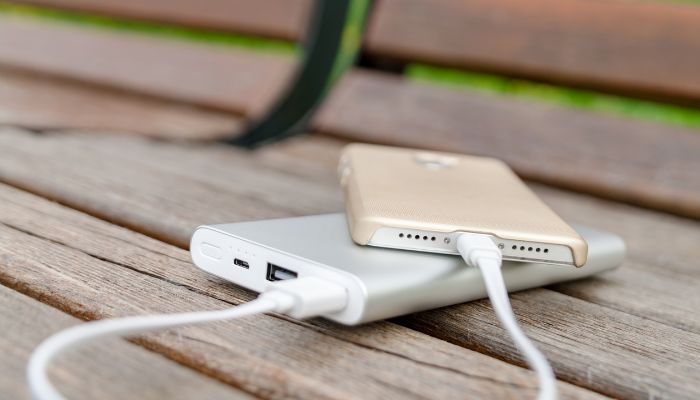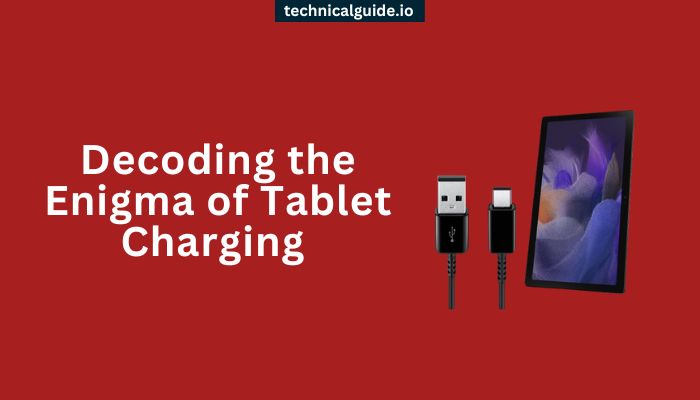Welcome to the world of tablets, where sleek designs meet cutting-edge technology to enhance our daily lives. These portable devices have become an integral part of our routine, serving as powerful tools for work, entertainment, and communication. However, even the most sophisticated tablets can encounter issues, and one of the most frustrating is the failure to charge properly.
In this blog post, we will delve into the intricate world of tablet charging mechanisms, exploring the reasons behind charging failures and providing practical solutions to ensure your tablet stays powered up when you need it the most.
How to Check If Your Tablet Is Charging or Not
Before we dive into troubleshooting, let’s establish how to identify whether your tablet is charging or not. Understanding the signs is crucial to pinpointing the issue and finding an appropriate solution.
Battery Icon
The first and most obvious sign is the battery icon on your tablet’s screen. A charging battery usually displays an animation or a static image indicating the charging process.
LED Indicator
Many tablets come equipped with LED indicators that change color or blink while charging. Familiarize yourself with your device’s indicator patterns to interpret its charging status.
Screen Display
In some cases, the tablet’s screen may show a charging symbol or percentage. Be attentive to any changes when you connect your tablet to a power source.
Now that we’ve established how to recognize the signs of charging, let’s explore the common issues that might hinder this process.
Common Causes of Tablet Not Charging
Faulty Cables and Adapters: The most common culprits are damaged or incompatible charging cables and adapters. Inspect them for frayed wires or bent pins.
Port Problems: Dust, debris, or a bent pin in the charging port can disrupt the connection between the cable and the tablet.
Battery Issues: Over time, batteries degrade. If your tablet struggles to hold a charge or doesn’t charge at all, the battery may need replacement.
Software Glitches: Occasionally, software issues can interfere with the charging process. Outdated software or corrupted files may disrupt the communication between the battery and the tablet.
With these potential causes in mind, let’s move on to the next crucial section: troubleshooting and fixing tablet charging issues.
How to Troubleshoot and Fix Tablet Not Charging Issues
Cable and Adapter Replacement
If your tablet isn’t charging, start by replacing the charging cable and adapter. Use only manufacturer-approved accessories to ensure compatibility.
Port Cleaning
Carefully clean the charging port using a can of compressed air or a small brush. Ensure there’s no debris or lint obstructing the connection.
Battery Replacement
If your tablet’s battery is old or damaged, consider replacing it. Consult the manufacturer’s guidelines or seek professional assistance.
Software Updates
Keep your tablet’s software up-to-date. Manufacturers often release updates to address bugs and improve device performance, including charging capabilities.
Factory Reset
As a last resort, perform a factory reset to eliminate any software glitches. Remember to back up your data before taking this step.
Now that you’re armed with solutions to tackle charging issues, let’s explore preventive measures to keep your tablet running smoothly.
How to Prevent Tablet Not Charging Issues in the Future
Regular Charging: Avoid letting your tablet’s battery drain completely. Charge it regularly to maintain optimal battery health.
Use Original Accessories: Stick to the original charging cable and adapter provided by the manufacturer. Generic accessories may not provide the necessary power or connectivity.
Port Maintenance: Keep the charging port clean and free of debris. A can of compressed air can help prevent dust accumulation.
Temperature Awareness: Extreme temperatures can impact battery performance. Avoid exposing your tablet to excessive heat or cold.
Update Wisely: Stay vigilant about software updates, but research them before installing. Sometimes, early versions may have bugs that could affect your tablet’s functionality.
What Is the Difference Between a Tablet and an iPad?
The terms “tablet” and “iPad” are often used interchangeably, but they refer to distinct categories of devices. Understanding the differences between them can help consumers make informed choices when purchasing technology. Let’s delve into the disparities between a tablet and an iPad:

Brand Specificity
Tablet
The term “tablet” is a generic one that encompasses a broad range of devices produced by various manufacturers, including Samsung, Lenovo, Amazon, and others. Tablets run on various operating systems, such as Android, Windows, or custom platforms.
iPad
An iPad, on the other hand, is a specific brand of tablet produced by Apple. iPads exclusively run on Apple’s iOS operating system, providing a consistent and integrated user experience across Apple devices.
Operating System
Tablet
Tablets can run on different operating systems, including Android, Windows, or specialized systems created by manufacturers.
iPad
iPads run on Apple’s iOS, which is known for its user-friendly interface, app ecosystem, and seamless integration with other Apple devices like iPhones, Macs, and Apple Watches.
App Ecosystem
Tablet
The app availability for tablets can vary depending on the operating system. For Android tablets, the Google Play Store offers a wide array of applications. Windows tablets have access to the Microsoft Store. Amazon tablets have their own app store.
iPad
iPads benefit from the extensive App Store, which is known for its vast selection of high-quality apps optimized for the iOS platform. Many developers prioritize iOS app development due to the popularity of Apple devices.
Hardware and Build Quality
Tablet
Tablets come in various sizes, designs, and build qualities, depending on the manufacturer. There is a wide range of options catering to different budgets and preferences.
iPad
iPads are renowned for their premium build quality, sleek designs, and high-resolution Retina displays. Apple places a strong emphasis on design aesthetics and materials, contributing to the perceived value of their devices.
Integration with Ecosystem
Tablet
Depending on the brand and operating system, tablets may or may not seamlessly integrate with other devices in a user’s tech ecosystem.
iPad
iPads are designed to seamlessly integrate with other Apple devices, allowing for features like Handoff, AirDrop, and iCloud synchronization. This cohesive ecosystem is often a significant selling point for users invested in Apple products.
Customization and Flexibility
Tablet
Tablets running on Android or Windows operating systems generally offer more customization options and flexibility in terms of file management, system tweaks, and personalization.
iPad
While iPads offer a highly polished and user-friendly experience, they are known for a more controlled environment. Customization options on iPads are more limited compared to some Android tablets.
Price Range
Tablet
The price range for tablets is extensive, catering to various budgets. Users can find affordable options as well as high-end tablets with premium features.
iPad
iPads, being a premium brand, often come with a higher price tag compared to many other tablets. However, Apple offers different iPad models at various price points to cater to a broader audience.
Conclusion
In conclusion, understanding the nuances of tablet charging is essential for maintaining a seamless user experience. By recognizing the signs of charging issues, identifying common causes, and implementing practical solutions, you can keep your tablet running efficiently.
Remember, preventive measures are key to avoiding future charging problems. Regular charging, using original accessories, keeping ports clean, and being mindful of environmental factors all contribute to a healthier tablet battery.
We hope this comprehensive guide empowers you to troubleshoot and prevent tablet charging issues effectively. Share your experiences and insights in the comments below, and let’s build a community of tablet enthusiasts supporting each other in the quest for optimal device performance. Happy charging!
1. Can I use The Same Apps On Any Tablet, Or Are They Device-Specific?
Answer: App availability depends on the operating system of the tablet. For iPads, apps are available on the Apple App Store and are designed specifically for iOS. Android tablets have their apps on the Google Play Store, and Windows tablets have their apps on the Microsoft Store. While some apps may be available on multiple platforms, not all apps are cross-compatible.
2. Are iPads Worth The Higher Price Compared to Other Tablets?
Answer: The value of an iPad depends on individual preferences and needs. iPads are known for their premium build quality, seamless integration with the Apple ecosystem, and a vast selection of high-quality apps. If these features are essential to you and align with your usage, an iPad may be worth the investment. However, there are many excellent tablets at various price points with different features, making them more budget-friendly options.
3. Can I Transfer Files Between My Tablet and Other Devices Easily?
Answer: The ease of file transfer depends on the operating system. iPads generally use iCloud and AirDrop for seamless file sharing within the Apple ecosystem. Android tablets often use Google Drive and Bluetooth for file transfers. Windows tablets may use OneDrive and other Windows-compatible methods. Additionally, third-party apps and cloud services are available for cross-platform file sharing.
4. How Long Does the Battery of a Typical Tablet or iPad Last?
Answer: Battery life varies among tablets and iPads. Factors such as screen brightness, app usage, and background processes impact battery consumption. On average, tablets can last anywhere from 6 to 12 hours on a single charge. iPads, known for their optimized hardware and software, often offer competitive battery life within this range.
5. Can I Use a Stylus or Pen With Any Tablet Or Just iPads?
Answer: The use of a stylus or pen depends on the tablet’s hardware and software support. While iPads, especially the iPad Pro models, are designed to work seamlessly with the Apple Pencil, many Android tablets also support stylus input. Windows tablets, particularly those in the Surface lineup, often come with stylus compatibility. However, not all tablets support stylus input, so it’s essential to check the device specifications before purchasing.
